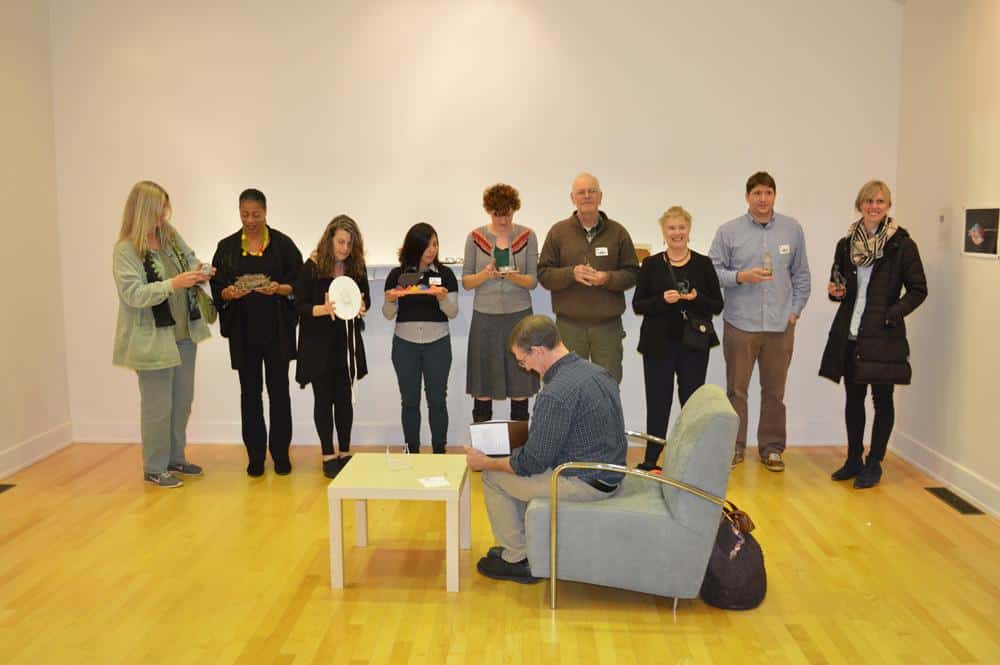
By and by…at home with Sam and Livy
Curators: Sarah Fritchey and Rashmi Talpade
December 2, 2015—March 4, 2016
Lani Asuncion, Joy Bush, Jeremy Chandler, David Coon, Joan Fitzsimmons, Clymenza Hawkins, Ellen Hoverkamp, Eben Kling, Sabrina Marques, Chris Mir, Christopher O’Flaherty, Scott Schuldt, and Jessica Smolinski.
For the exhibition, By and by…at home with Sam and Livy, Artspace curators Sarah Fritchey and Rashmi Talpade remake the rules of a game played by the American author, Samuel Clemens, better known as Mark Twain, in his Hartford home, bringing it into the white cube setting. Presented at The Gallery at Constitution Plaza in the Connecticut Office of the Arts, the exhibition features works on paper by 13 artists who share Clemens’s aptitude for storytelling, humor, and symbolism. The curators selected the work from Artspace’s Flatfile Collection, a growing body of works on paper by 150 regional artists and counting.
The rules of the game were simple. After dinner, Sam and Livy Clemens would gather with their daughters in their library, where Sam would stand in front of their great oak mantelpiece and tell a series of stories. The rule, set by his daughters, was to always start with the painting of the cat in an Elizabethan ruffed collar (commonly referred here as the ‘cat in the ruff’). Then, Clemens had to use every item on the mantel in the story in some way, in order, from the cat to the Impressionist painting of a lady in blue, who they had named Emmeline. If he skipped an item, went out of order, or repeated a story from a different night, he had to start over. Of the objects on the mantle, Clemens said “Those bric-a-bracs were never allowed a peaceful day, a reposeful day, a restful Sabbath. In their lives there was no Sabbath; in their lives there was no peace; they knew no existence but a monotonous career of violence and bloodshed. In the course of time the bric-a-brac and the pictures showed wear.”
Today, the Mark Twain House displays 13 objects on the mantelpiece, including a conch shell, gold plate, white marble statue, painted portrait of a lady, miniature harp, sculptural relief of Clemens, 3 alabaster blue vases, and the painting of the “cat in the ruff”.
Visitors to the Artspace exhibition will find 13 contemporary objects on a replica mantelpiece, provided by the 13 artists in the show. The curators asked each artist to identify one object that relates to their selected body of work. The artists were allowed to interpret this prompt as they wished, with one simple restriction, that the object be small enough to fit on the mantelpiece. Visitors are invited to handle these objects, and rearrange them to activate a new imagined story. Should they wish, visitors may curl up in the reading chair, placed in front of what would be the fireplace, to record a one-page version of their story.
This homage to the historic Mark Twain House celebrates the basic practices of collecting, presenting, conserving, and interpreting objects. The show is organized as a part of Artspace’s 30th Anniversary program series, Three Decades of Change, which is dedicated to experimenting with playful ways of reawakening and performing archives. The Clemens’ practice of traveling, importing, and collecting objects recalls the origins of museums, which started in the homes of nobles. Sam’s game points to the fundamental aspects of curating, realizing how the methods by which we assemble, encounter, and describe an object dictates its historic interpretation. Here, storytelling preserves a space for imagining new life into old objects.